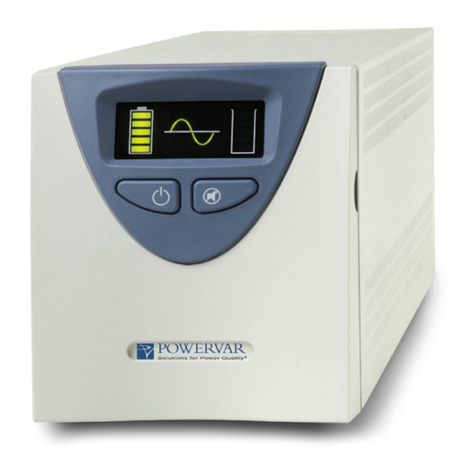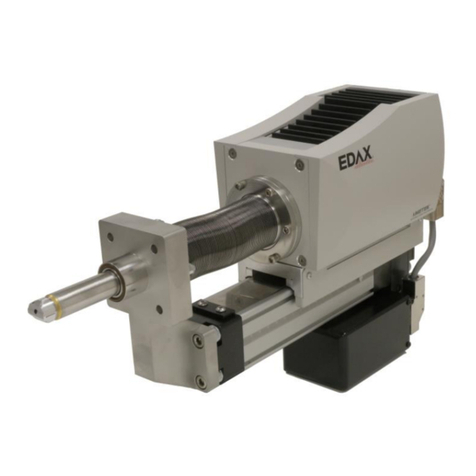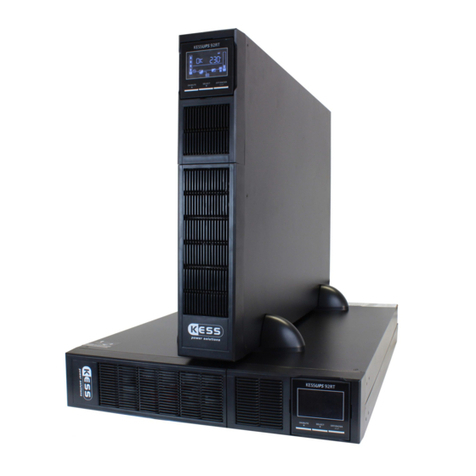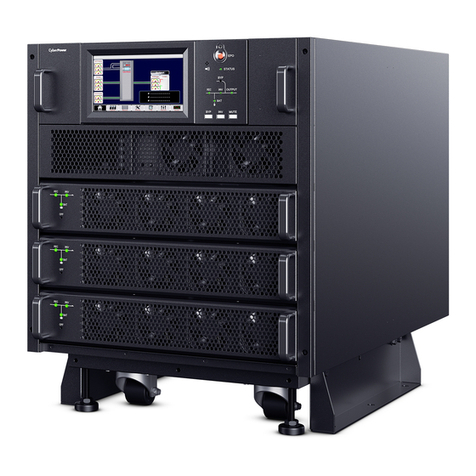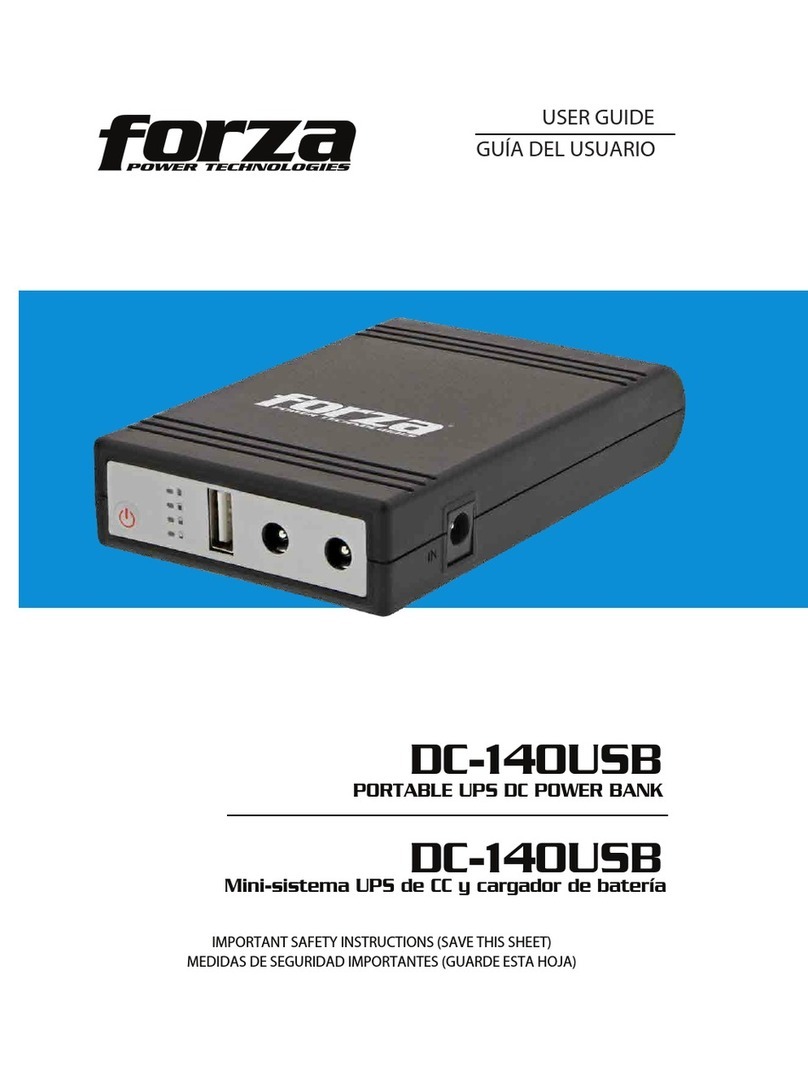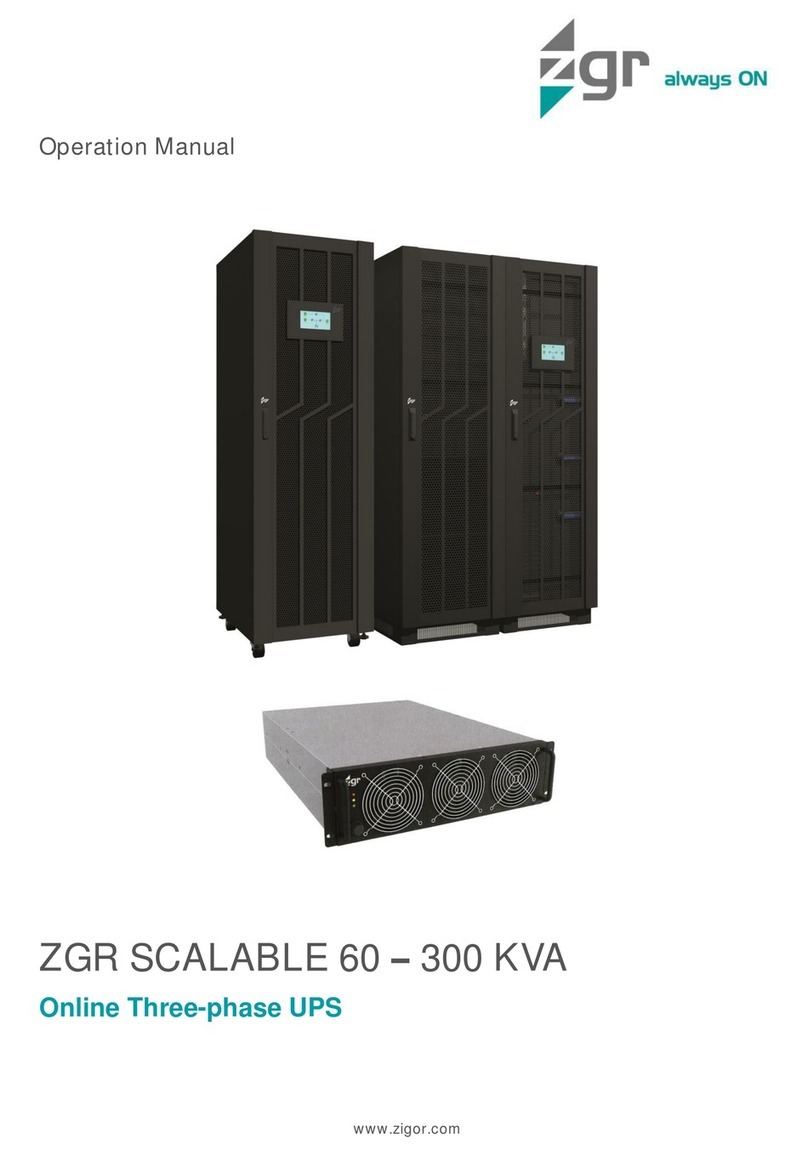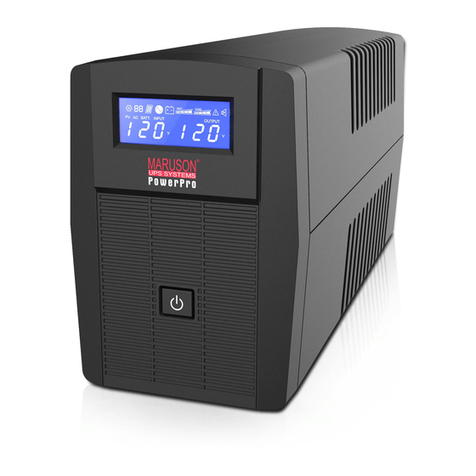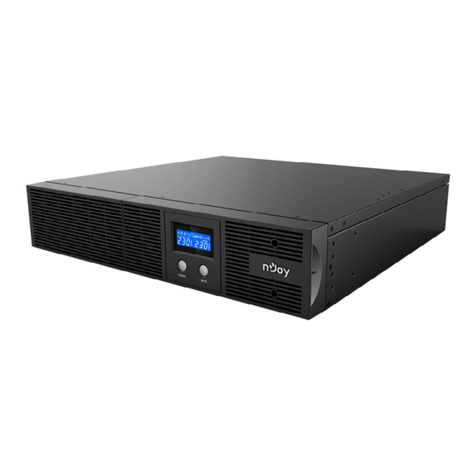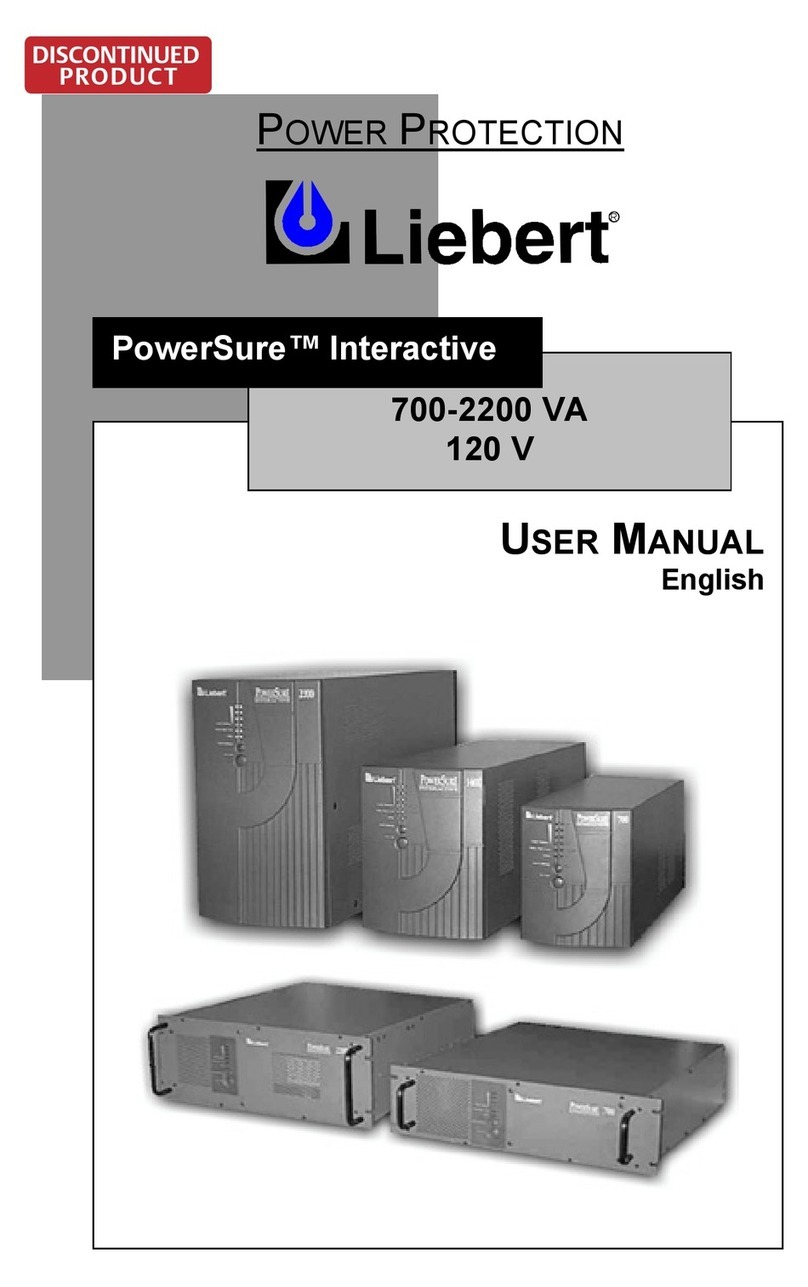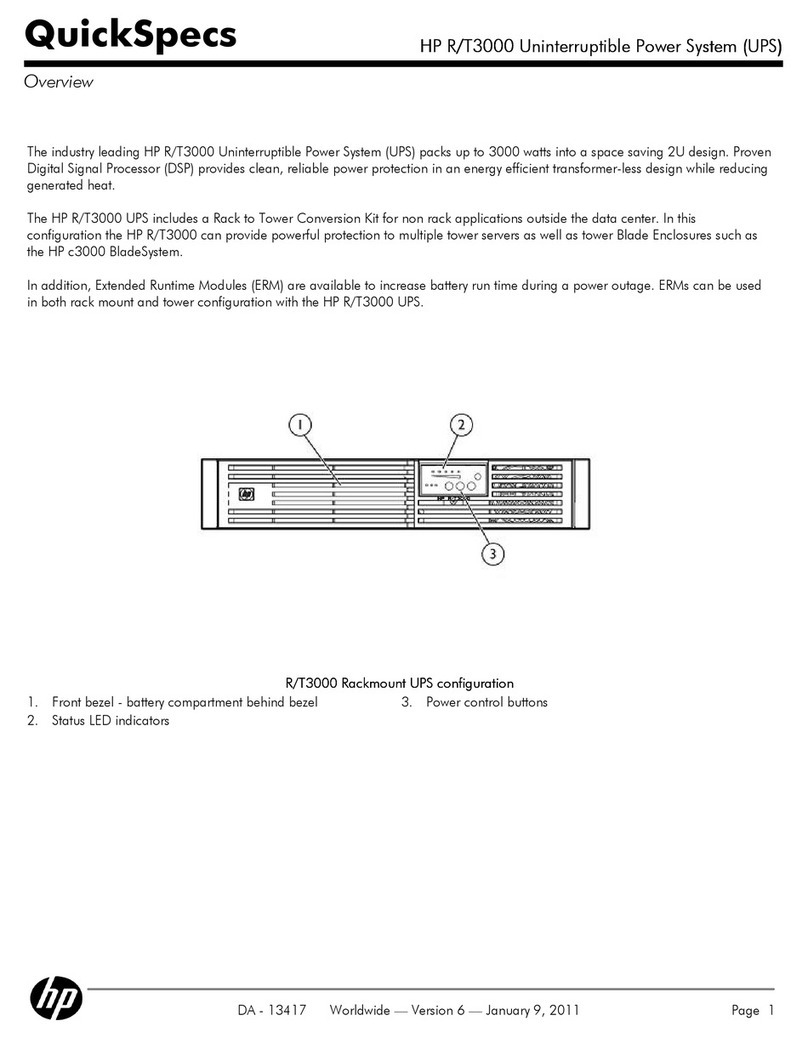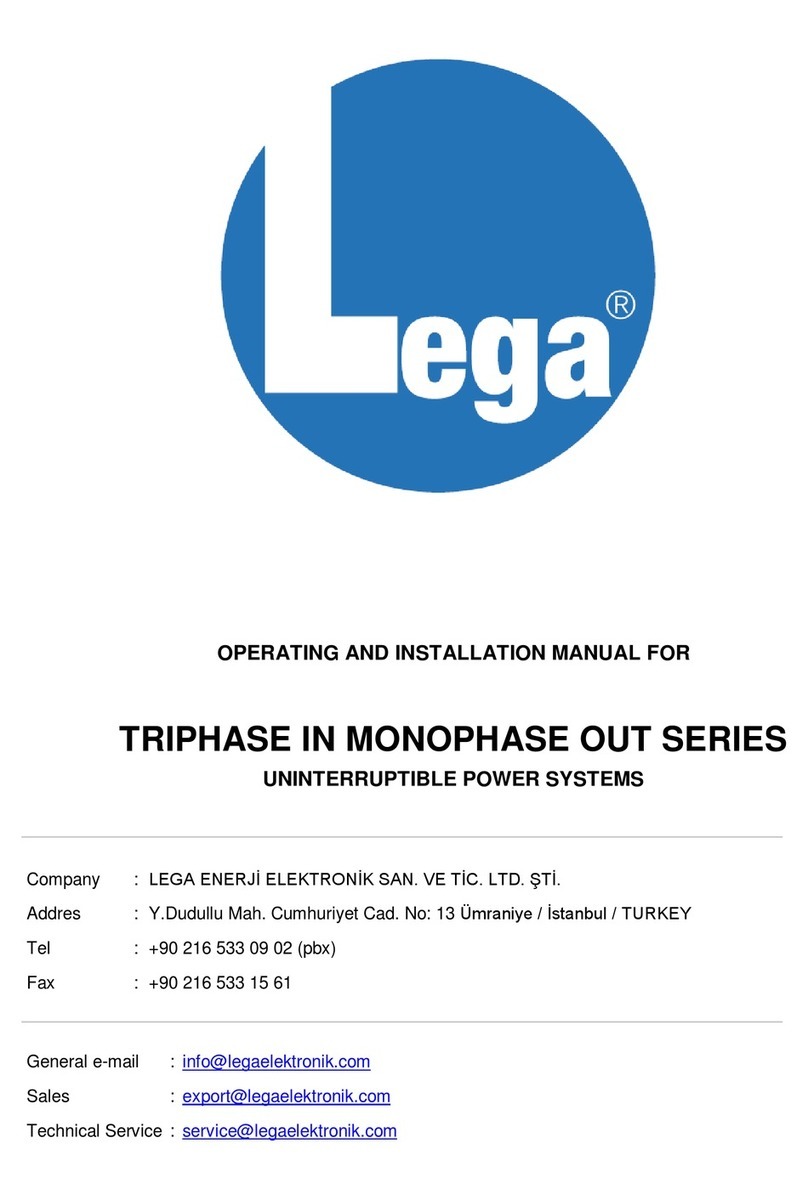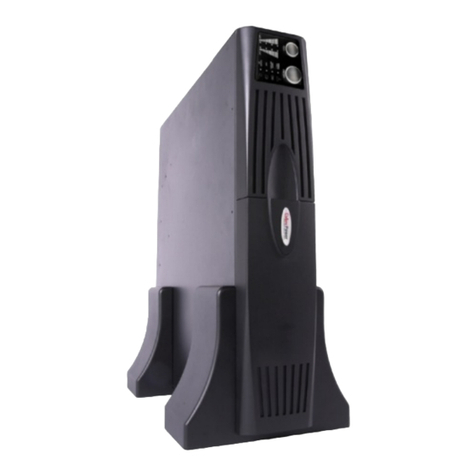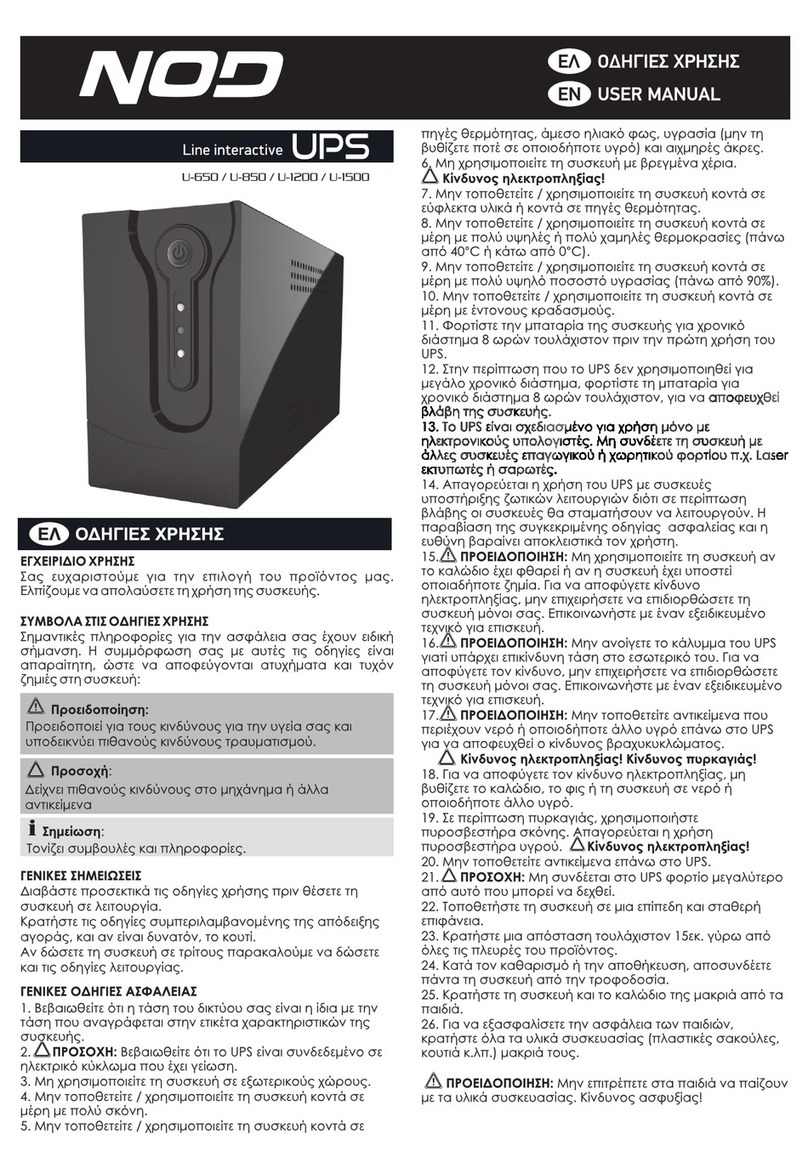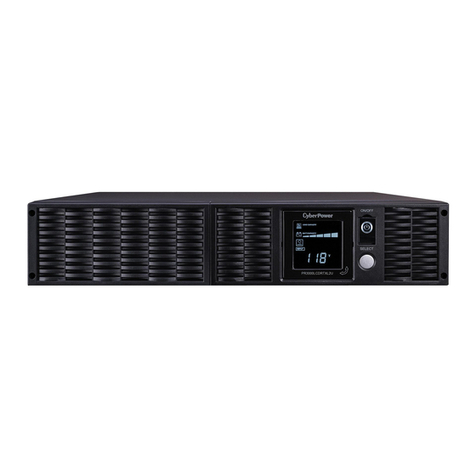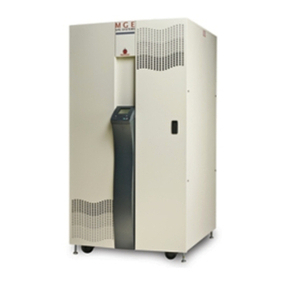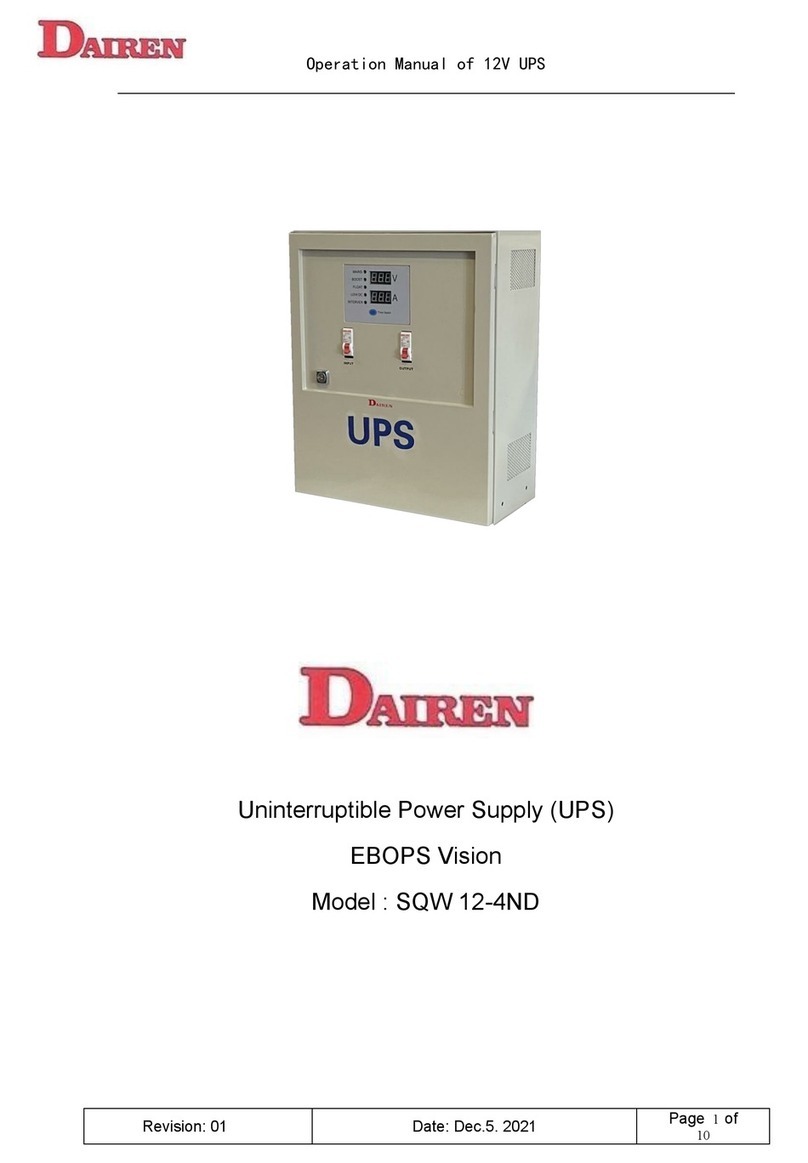Metek GUPS 2400A-104 User manual

Contact Information
Telephone: 800 733 5427 (toll free in North America)
858 450 0085 (direct)
Fax: 858 458 0267
Email:
International Sales: intlorders.sd@ametek.com
Web: www.programmablepower.com
GLOBAL
UNINTERRUPTIBLE
POWER SUPPLY
Model GUPS 2400A–104
Operation Manual
March 2011 Document No. M152332-01 Rev C


i
About AMETEK
AMETEK Programmable Power, Inc., a Division of AMETEK, Inc., is a global leader in the design
and manufacture of precision, programmable power supplies for R&D, test and measurement,
process control, power bus simulation and power conditioning applications across diverse
industrial segments. From bench top supplies to rack-mounted industrial power subsystems,
AMETEK Programmable Power is the proud manufacturer of Elgar, Sorensen, California
Instruments and Power Ten brand power supplies.
AMETEK, Inc. is a leading global manufacturer of electronic instruments and electromechanical
devices with annualized sales of $2.5 billion. The Company has over 11,000 colleagues working
at more than 80 manufacturing facilities and more than 80 sales and service centers in the United
States and around the world.
Trademarks
AMETEK is a registered trademark of AMETEK, Inc.
Other trademarks, registered trademarks, and product names are the property of their respective
owners and are used herein for identification purposes only.
Notice of Copyright
Global Uninterruptible Power Supply, Operation Manual
© 2010 AMETEK Programmable Power,
Inc. All rights reserved.
Exclusion for Documentation
UNLESS SPECIFICALLY AGREED TO IN WRITING, AMETEK PROGRAMMABLE POWER, INC.
(“AMETEK”):
(a) MAKES NO WARRANTY AS TO THE ACCURACY, SUFFICIENCY OR SUITABILITY OF ANY
TECHNICAL OR OTHER INFORMATION PROVIDED IN ITS MANUALS OR OTHER
DOCUMENTATION.
(b) ASSUMES NO RESPONSIBILITY OR LIABILITY FOR LOSSES, DAMAGES, COSTS OR
EXPENSES, WHETHER SPECIAL, DIRECT, INDIRECT, CONSEQUENTIAL OR INCIDENTAL,
WHICH MIGHT ARISE OUT OF THE USE OF SUCH INFORMATION. THE USE OF ANY SUCH
INFORMATION WILL BE ENTIRELY AT THE USER’S RISK, AND
(c) REMINDS YOU THAT IF THIS MANUAL IS IN ANY LANGUAGE OTHER THAN ENGLISH,
ALTHOUGH STEPS HAVE BEEN TAKEN TO MAINTAIN THE ACCURACY OF THE
TRANSLATION, THE ACCURACY CANNOT BE GUARANTEED. APPROVED AMETEK CONTENT
IS CONTAINED WITH THE ENGLISH LANGUAGE VERSION, WHICH IS POSTED AT
WWW.PROGRAMMABLEPOWER.COM.
Date and Revision
March 2011 Rev C
Part Number
M152332-01
Contact Information
Telephone: 800 733 5427 (toll free in North America)
858 450 0085 (direct)
Fax: 858 458 0267
Email: sales@programmablepower.com
service@programmablepower.com
Web: www.programmablepower.com

ii
This page intentionally left blank.

iii
Important Safety Instructions
Before applying power to the system, verify that your product is configured properly for your
particular application.
WARNING
Hazardous voltages may be present when covers are removed. Qualified
personnel must use extreme caution when servicing this equipment.
Circuit boards, test points, and output voltages also may be floating above
(below) chassis ground.
WARNING
The equipment used contains ESD sensitive ports. When installing
equipment, follow ESD Safety Procedures. Electrostatic discharges might
cause damage to the equipment.
Only qualified personnel who deal with attendant hazards in power supplies, are allowed to perform
installation and servicing.
Ensure that the AC power line ground is connected properly to the Power Rack input connector or
chassis. Similarly, other power ground lines including those to application and maintenance
equipment must be grounded properly for both personnel and equipment safety.
Always ensure that facility AC input power is de-energized prior to connecting or disconnecting any
cable.
In normal operation, the operator does not have access to hazardous voltages within the chassis.
However, depending on the user’s application configuration, HIGH VOLTAGES HAZARDOUS TO
HUMAN SAFETY may be normally generated on the output terminals. The customer/user must
ensure that the output power lines are labeled properly as to the safety hazards and that any
inadvertent contact with hazardous voltages is eliminated.
Guard against risks of electrical shock during open cover checks by not touching any portion of the
electrical circuits. Even when power is off, capacitors may retain an electrical charge. Use safety
glasses during open cover checks to avoid personal injury by any sudden component failure.
Neither AMETEK Programmable Power Inc., San Diego, California, USA, nor any of the subsidiary
sales organizations can accept any responsibility for personnel, material or inconsequential injury,
loss or damage that results from improper use of the equipment and accessories.
SAFETY SYMBOLS

iv
Product Family: GUPS 2400A-104
Warranty Period: One Year
WARRANTY TERMS
AMETEK Programmable Power, Inc. (“AMETEK”), provides this written warranty covering the
Product stated above, and if the Buyer discovers and notifies AMETEK in writing of any defect in
material or workmanship within the applicable warranty period stated above, then AMETEK may,
at its option: repair or replace the Product; or issue a credit note for the defective Product; or
provide the Buyer with replacement parts for the Product.
The Buyer will, at its expense, return the defective Product or parts thereof to AMETEK in
accordance with the return procedure specified below. AMETEK will, at its expense, deliver the
repaired or replaced Product or parts to the Buyer. Any warranty of AMETEK will not apply if the
Buyer is in default under the Purchase Order Agreement or where the Product or any part
thereof:
is damaged by misuse, accident, negligence or failure to maintain the same as
specified or required by AMETEK;
is damaged by modifications, alterations or attachments thereto which are not
authorized by AMETEK;
is installed or operated contrary to the instructions of AMETEK;
is opened, modified or disassembled in any way without AMETEK’s consent; or
is used in combination with items, articles or materials not authorized by AMETEK.
The Buyer may not assert any claim that the Products are not in conformity with any warranty
until the Buyer has made all payments to AMETEK provided for in the Purchase Order Agreement.
PRODUCT RETURN PROCEDURE
1. Request a Return Material Authorization (RMA) number from the repair facility (must be
done in the country in which it was purchased):
In the USA, contact the AMETEK Repair Department prior to the return of the
product to AMETEK for repair:
Telephone: 800-733-5427, ext. 2295 or ext. 2463 (toll free North America)
858-450-0085, ext. 2295 or ext. 2463 (direct)
Outside the United States, contact the nearest Authorized Service Center
(ASC). A full listing can be found either through your local distributor or our
website, www.programmablepower.com, by clicking Support and going to the
Service Centers tab.
2. When requesting an RMA, have the following information ready:
Model number
Serial number
Description of the problem
NOTE: Unauthorized returns will not be accepted and will be returned at the shipper’s expense.
NOTE: A returned product found upon inspection by AMETEK, to be in specification is subject to
an evaluation fee and applicable freight charges.

GUPS 2400A–104 Operation Manual v
CONTENTS
SECTION 1 OVERVIEW AND SPECIFICATIONS.................................1-1
1.1 Introduction ....................................................................................................1-1
1.2 General Description........................................................................................1-1
1.3 Specifications.................................................................................................1-1
SECTION 2 INSTALLATION ...............................................................2-1
2.1 Introduction ....................................................................................................2-1
2.2 Unpacking and Inspection..............................................................................2-1
2.3 Installation......................................................................................................2-2
2.4 Air Intake and Exhaust ...................................................................................2-2
2.5 Input/Output Connectors................................................................................2-2
2.6 Wire Gauge Selection ....................................................................................2-6
SECTION 3 OPERATION.....................................................................3-1
3.1 Introduction ....................................................................................................3-1
3.2 Control and Indicator Panel............................................................................3-1
3.2.1 Indicators............................................................................................3-1
3.2.2 Pushbutton Switches..........................................................................3-2
3.3 Circuit Breakers..............................................................................................3-3
3.4 Audible Alarm.................................................................................................3-3
3.5 Control Signals...............................................................................................3-3
3.6 Connectors.....................................................................................................3-4
3.7 Start-Up and Shutdown Sequences ...............................................................3-5
3.8 Battery Operation...........................................................................................3-5
3.8.1 Battery Care and Handling .................................................................3-6
3.9 RS-232 Data Communications Port................................................................3-7
3.9.1 Hardware Interface.............................................................................3-7

Contents
vi GUPS 2400A–104 Operation Manual
3.9.2 Software Interface...............................................................................3-7
3.9.3 RS-232 Protocol .................................................................................3-8
3.9.4 Test Data Request Commands...........................................................3-8
3.9.5 Elgar Terminal Interface (ETI) Data Request Commands...................3-10
3.9.6 Status Words....................................................................................3-11
3.9.7 AC Line Loss Signal .........................................................................3-16
SECTION 4 MAINTENANCE............................................................... 4-1
4.1 Introduction.....................................................................................................4-1
4.2 Service Information.........................................................................................4-1
4.3 Spare and Repair Parts..................................................................................4-1
4.4 Periodic Maintenance.....................................................................................4-1
4.5 Troubleshooting..............................................................................................4-2
LIST OF FIGURES
Figure 2–1. GUPS 2400A–104 (Front View)................................................................2-3
Figure 2–2. GUPS 2400A–104 (Rear View)................................................................2-4
Figure 2–3. GUPS 2400A–104 Dimensions (Top, Side, and Front Views) ..................2-5
Figure 3–1. GUPS 2400A–104 Control and Indicator Panel........................................3-2
LIST OF TABLES
Table 2–1. GUPS 2400A–104 Input/Output Connectors .............................................2-2
Table 2–2. Recommended Wire Gauge Selection Guide ............................................2-6
Table 3–1. GUPS 2400A–104 Connector Pin Assignments ........................................3-4
Table 3–2. Battery Storage Times...............................................................................3-6
Table 3–3. RS-232 Connector Pin-Out........................................................................3-7
Table 3–4. RS-232 Communications Port Protocol .....................................................3-8
Table 3–5. Status Word 1 Data Format.....................................................................3-11
Table 3–6. Status Word 2 Data Format.....................................................................3-14
Table 4–1. GUPS 2400A-104 Troubleshooting Guide.................................................4-2

GUPS 2400A–104 Operation Manual 1-1
SECTION 1
OVERVIEW AND SPECIFICATIONS
1.1 Introduction
The Elgar Model GUPS 2400A-104 is a 2400 VA Global Uninterruptible Power Supply (GUPS)
that provides regulated 115 VRMS, 60 Hz output power at up to 20.9 Amps RMS load current.
The GUPS 2400A-104 accepts 3-phase AC input line voltages from 159V to 232V at
frequencies from 370 Hz to 430 Hz. A battery backup of five minutes at 2400 VA output is
provided by a removable battery pack. Output power is continuous when transferring from AC to
battery or battery to AC.
1.2 General Description
The GUPS 2400A-104 is contained in a rack-mount enclosure. All input and output connections
are made at the rear panel. Cooling air is drawn in through a filter on the front panel and
exhausted out the rear panel. Operational and input/output power status is indicated by front
panel LEDs. An AC input circuit breaker and control pushbutton switches also are located on
the front panel. There are no operator adjustments.
1.3 Specifications
(Specifications Subject to Change Without Notice)
AC Input Voltage: 115/200V, 3-phase, 3-wire plus ground, neutral not used;
159V to 232V, line voltage;
92V to 134V, phase voltage
AC Input Current: 9.8A, maximum at 200V, 2400VA/1920W load, fully charged battery;
12.5A, maximum at 159V, 2400VA/1920W load, charging battery
AC Input Frequency: 370Hz to 430Hz
Batteries: 192VDC, sealed, maintenance-free, lead-acid
Battery Hold-Up Time: 5 minutes with a 2400VA/1920W load at 25°C
Battery Recharge Time: 4 hours to 90% full charge following discharge
at 2400VA/1920W and 25°C

Overview and Specifications
1-2 GUPS 2400A–104 Operation Manual
Output Voltage: 115V, ±2%
Output Frequency: 60Hz, ±0.1%
Output Current: 20.9A(RMS)
Output Distortion: 2% THD, maximum with linear load
Output Power: 1920W with resistive load;
2400VA/1920W with a reactive load or a non-linear load
Efficiency: 77%
AC to Battery Crossover: 159V, maximum low-line voltage;
232V, minimum high-line voltage
Battery to AC Crossover: 169V, maximum low-line voltage;
232V, minimum high-line voltage
AC Input Voltage Unbalance: 7V (RMS) maximum difference in line voltages
Temperature: 0°C to 40°C (32°F to 104°F), operating;
-40°C to 65°C (-40°F to 149°F), non-operating
Humidity: 5% to 95% non-condensing, operating
Altitude: 0 to 10,000ft, operating;
0 to 40,000ft, 2000ft/min, maximum, non-operating
Dimensions: 7"H x 19"W x 25.1"D,
excluding protrusion of handles, controls, and connectors;
fits standard RETMA rack
Weight: 75lb (34kg), UPS enclosure;
48lb (22kg) battery module;
123lb (56kg) total weight

GUPS 2400A–104 Operation Manual 2-1
SECTION 2
INSTALLATION
2.1 Introduction
The Elgar Model GUPS 2400A–104 has been aligned, calibrated, and tested prior to shipment.
The instrument is ready for immediate use upon receipt. However, the following checks should
be made to ensure that the instrument was not damaged during shipment.
CAUTION!
The GUPS 2400A–104 weighs 75 pounds (34 kg) without the
battery pack. The battery pack adds an additional 48 pounds
(22 kg). A minimum two–person lift is required!
WARNING!
Hazardous voltages are present when operating this equipment.
Please read the SAFETY NOTICE on page iv prior to installation,
operation, or maintenance.
2.2 Unpacking and Inspection
Perform a visual inspection of the shipping container prior to accepting the package from the
carrier. If extensive damage is evident, a description of the damage should be noted on the
carrier's receipt and signed by the driver of the carrier agent.
If damage is not apparent until the instrument is unpacked, a claim for concealed damage
should be placed with the carrier. Check for shipping damage such as dents, scratches,
distortion, and damaged connectors. If the instrument or container(s) show signs of rough
handling, remove the covers from the instrument to ensure that the circuit boards are securely in
place and that no loose or broken components are evident.
In addition, the shipping container(s) and filler material should be saved for inspection. Forward
a report of damage to the Elgar Service Department. Elgar will provide instructions for repair or
replacement of the instrument.

Installation
2-2 GUPS 2400A–104 Operation Manual
When returning the instrument to Elgar, suitable shipping containers and packing material must
be used. If the instrument needs to be shipped and proper packing material is not available,
contact Elgar to provide containers and shipping instructions.
2.3 Installation
The Model GUPS 2400A–104 is 7" (178 mm) high and is designed to be installed in a standard
19" (483 mm) wide cabinet enclosure or a transit case.
Refer to Figure 2–1 through Figure 2–3 for information on outline and mounting dimensions.
2.4 Air Intake and Exhaust
The air intake is located on the front panel of the instrument and the exhaust is through the rear
panel. Care must be taken not to block the air intake and exhaust. No special vertical
separation is required when stacking instruments. However, a 1¾" (44.5 mm) vertical spacer
above and below the instrument may improve cooling.
CAUTION!
Avoid blocking the instrument air intakes or exhaust.
2.5 Input/Output Connectors
Table 2–1 provides a listing of the GUPS 2400A–104 input and output connectors.
J1: AC Input Connector
Panel Connector
PT02CE-14-5P
Mating Connector
PT06CE-14-5S (SR)
J2–J7: AC Output Connectors
Panel Connector
PT02CE-12-3SY
Mating Connector
PT06CE-12-3PY (SR)
J8: Data/Alarm Port Connector
Panel Connector
PT02CE-12-8S
Mating Connector
PT06CE-12-8P (SR)
Table 2–1. GUPS 2400A–104 Input/Output Connectors

Installation
GUPS 2400A–104 Operation Manual 2-3
DISPLAY PANEL
4X HANDLE
(6.968)
4 x .25
4 x .50
(19.00)
(4.000)
(1.485)
AC INPUT CIRCUIT BRKR
REMOVABLE AIR FILTER
(INTAKE) REMOVABLE BATTERY MODULE
AC INPUT
PUSHON/PULL OFF BATTERY MODULE
WARNING
REMOVE BATTERIES BEFORE SHIPMENT OR
INACTIVE STORAGE OF 30 DAYS OR MORE
ON
BATT
OUTPUT
ON
ALARM
SILENCE
BATT
LOAD
TEMP
TEST
TEST
AC INPUT
-AB -AC -BC
GUPS 2400A-104
GLOBAL UPS
Figure 2-1 GUPS 2400A-104 (Front View)
Figure 2–1. GUPS 2400A–104 (Front View)

Installation
2-4 GUPS 2400A–104 Operation Manual
AC INPUT
CONNECTOR
AC OUTPUT
CONNECTOR
OUTPUT POWER
CIRCUIT BREAKER
OUTPUT POWER
CIRCUIT BREAKER
CHASSIS
GROUND STUD
DATA/ALARM PORT
AC OUTPUT, 10A MAX
AC OUTPUT, 15A MAX
CB1
CB2
J2
J5
J3
J6
J4
J7
TOTAL AC OUTPUT: 20.9A MAX
Figure 2-2 GUPS 2400A-104 (Rear View)
CAUTION:
WARNING:
NO OPERATOR SERVICEABLE PARTS INSIDE.
REFER SERVICING TO QUALIFIED PERSONNEL.
TO AVOID ELECTRICAL SHOCK, THE CHASSIS
MUST BE CONNECTED TO EARTH GROUND.
GND
J1
AC INPUT
J8
DATA/ALARM
PORT
Part No: 5152332-01
Serial No: Revision: A
Date Code:
San Diego, CA
Ac Input:
Ac Output:
200/115V, 3-Phase, 370-430Hz
3-Wire Plus Ground; Neutral Not Used
159-232V, Max Phase-To-Phase
12.5A, Max At 159V
115V, 1-Phase, 60Hz
2,400VA/1920W,Max
Figure 2–2. GUPS 2400A–104 (Rear View)

Installation
GUPS 2400A–104 Operation Manual 2-5
12X PN LAC-032-2
BOTTOM OF CHASSIS
TO TOP COVER
BOTTOM EDGE OF
FRONT PANEL
5 EQ SP @ 3.875 = 19.375
.625
1.730 6.920
25.10
.160
1.75
16.90
15.60
1.75
.65
.825
HIGH VOLTAGE IS
EXPOSED WHEN
COVER REMOVED
DANGER
CAUTION
ELECTROSTATIC SENSITIVE EQUIPMENT
SPECIAL HANDLING RE QUIRED
2-MAN LIFT
REQUIRED
CAUTION
Figure 2-3 GUPS 2400A-104 (Top and Side Views)
Figure 2–3. GUPS 2400A–104 Dimensions (Top, Side, and Front Views)

Installation
2-6 GUPS 2400A–104 Operation Manual
2.6 Wire Gauge Selection
The following guidelines assist in determining the optimum cable specification for the user's
power applications. These guidelines are equally applicable to both DC and low frequency AC
(up to 450 Hz) power cabling. The same engineering rules apply whether going into or out of an
electrical device. Thus, this guide applies equally to the input cable and output cable for this
Elgar instrument and application loads.
Power cables must be able to safely carry maximum load current without overheating or causing
insulation destruction. It is important to everyday performance to minimize IR (voltage drop)
loss within the cable. These losses have a direct effect on the quality of power delivered to and
from instruments and corresponding loads.
When specifying wire gauge, the operating temperature needs to be considered. Wire gauge
current capability and insulation performance drops with the increased temperature developed
within a cable bundle and with increased environmental temperature. Thus, short cables with
generously derated gauge and insulation properties are recommended for power source
applications.
Avoid using published commercial utility wiring codes. These codes are designed for the
internal wiring of homes and buildings and accommodate the safety factors of wiring loss, heat,
breakdown insulation, aging, etc. However, these codes consider that up to 5% voltage drop is
acceptable.
Such a loss directly detracts from the quality performance specifications of this instrument.
Frequently, these codes do not consider bundles of wire within a cable arrangement.
In high performance applications, as in motor start-up and associated inrush/ transient currents,
additional consideration is required. The cable wire gauge must consider peak voltages and
currents which may be up to ten times the average values. An underrated wire gauge adds
losses which alter the inrush characteristics of the application and thus the expected
performance.
Table 2–2 identifies popular ratings for DC and AC power source cable wire gauges.
Column 1
Size
(AWG)
Column 2
Amperes
(Maximum)
Column 3
Ohms/100 Feet
(One Way)
Column 4
IR Drop/100 Feet
(Col. 2 x Col. 3)
14
15
0.257
3.85
12
20
0.162
3.24
10
30
0.102
3.06
8
40
0.064
2.56
6
55
0.043
2.36
4
70
0.025
1.75
2
95
0.015
1.42
1/0
125
0.010
1.25
3/0
165
0.006
1.04
Table 2–2. Recommended Wire Gauge Selection Guide

Installation
GUPS 2400A–104 Operation Manual 2-7
The following notes apply to Table 2–2 and to the power cable definition:
1. The above figures are based upon insulated copper conductors at 25°C (77°F), two current
carrying conductors in the cable plus a safety (chassis) ground.
Columns 3 and 4 refer to "one way" ohms and IR drop of current carrying conductors
(e.g., a 50-foot cable contains 100 feet of current carrying conductor).
2. Determine which wire gauge for the application by knowing the expected peak load current
(Ipeak), the maximum tolerated voltage loss (Vloss) within the cable, and the one way cable
length. The formula below determines which ohms/100 feet entry is required from Column
3. Read the corresponding wire gauge from Column 1.
(Column 3 value) = Vloss/[Ipeak x 0.02 x (cable length)]
Where:
Column 3 value = Entry of the table above.
Cable length = One way cable length in feet.
Vloss = Maximum loss, in volts, permitted within cable.
SPECIAL CASE:
Should the Vloss requirement be very loose, Ipeak may exceed the maximum amperes
(Column 2). In this case, the correct wire gauge is selected directly from the first two
columns of the table.
EXAMPLE:
A 20 ampere (Ipeak) circuit which may have a maximum 0.5 volt drop (Vloss) along its
15-foot cable (one way cable length) requires (by formula) a Column 3 resistance value
of 0.083. This corresponds to wire gauge size 8 AWG.
If the cable length was 10 feet, the Column 3 value would be 0.125 and the
corresponding wire gauge would be 10 AWG.
3. Aluminum wire is not recommended due to soft metal migration at the terminals which may
cause long term (on the order of years) poor connections and oxidation. If used, increase the
wire gauge by two sizes (e.g., specify 10 gauge aluminum instead of 14 gauge aluminum).
4. Derate the above wire gauge (use a heavier gauge) for higher environmental temperatures
since conductor resistance increases with temperature.
Temperature Current
°C °F Capability
40 104 80%

Installation
2-8 GUPS 2400A–104 Operation Manual
5. Derate the above wire gauge (use a heavier gauge) for an increased number of current
carrying conductors. This offsets the thermal rise of bundled conductors.
Number of Current
Conductors Capability
3 to 6 80%
Above 6 70%
6. The preferred insulation material is application dependent. Elgar recommends any flame
retardant, heat resistant, moisture resistant thermoplastic insulation rated to a nominal 75°C
(167°F). Voltage breakdown must exceed the combined effects of:
•The rated output voltage;
•Transient voltages induced onto the conductors from any source;
•The differential voltage to other nearby conductors; and,
•Safety margins to accommodate degradations due to age, mechanical abrasion and
insulation migration caused by bending and temperature.
7. As frequency increases, the magnetic field of the current carrying conductors becomes more
significant in terms of adverse coupling to adjacent electrical circuits. Use twisted pairs to
help cancel these effects. Shielded twisted pairs are even better. Avoid close coupling with
nearby cables by using separate cable runs for high power and low power cables.
8. The above general values and recommendations should be reviewed, modified and
amended, as necessary, for each application. Cables should be marked with appropriate
safety WARNING decals as hazardous voltages may be present.

GUPS 2400A–104 Operation Manual 3-1
SECTION 3
OPERATION
3.1 Introduction
This section provides detailed information on the controls and indicators, input/output
connections, start-up and shutdown sequences, battery operation, and the RS-232 data
communications port.
3.2 Control and Indicator Panel
All controls and indicators for the GUPS 2400A–104 are located on the front panel of the unit.
There are no operator adjustments inside the unit. Refer to Figure 3–1 for the location of the
controls and indicators listed below.
There are eight indicators and three pushbutton switches on the panel. In addition, there is an
input circuit breaker located below the control panel.
3.2.1 Indicators
AC INPUT. Three green LEDs that indicate the presence of line voltage at the AC input. The
indicators turn on when the line voltage is greater than 90V (phase voltage greater than 52V).
ON BATT. An amber LED that indicates the loss of AC input and operation from battery
power.
BATT. A three-color LED that indicates the condition of the battery. The LED is green under
normal operating conditions, amber when the battery is discharging or has low capacity while
charging, and red when the battery capacity is low and impending inverter shutdown is
approached.
LOAD. A three-color LED that indicates the amount of output load. The LED is green when the
load is less than 80% of maximum output, amber when the load is within 80% to 105%, and red
when the load exceeds 105% (indicating the inverter will shut down if the load is maintained).
TEMP. A two-color LED that indicates temperature condition within the GUPS. The LED is
green under normal operating conditions, and red when an over-temperature shutdown occurs.

Operation
3-2 GUPS 2400A–104 Operation Manual
TEST. A two-color LED that indicates the results of the internal self-test. The LED blinks while
a self-test is in progress. When the test is complete, the LED turns green if the test is passed
and red it the test is failed.
3.2.2 Pushbutton Switches
OUTPUT ON. A momentary pushbutton switch on the front panel that alternately turns the
output power on and off.
TEST. A momentary push button switch on the front panel that initiates the internal self-test.
ALARM SILENCE. A momentary pushbutton switch on the front panel that silences the
audible alarm.
GUPS 2400A-104
LOAD
PUSH-ON/PULL-OFF
AC INPUT
15
TEST
SILENCE
ALARM
TEMP
TEST
-BC
OUTPUT
ON
ON
BATT
BATT
-AC
AC INPUT
-AB
GLOBAL UPS
Figure 3–1. GUPS 2400A–104 Control and Indicator Panel
Table of contents
Other Metek UPS manuals
